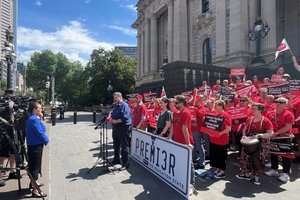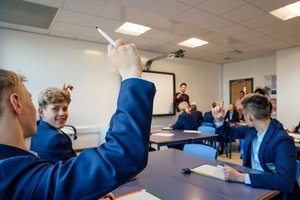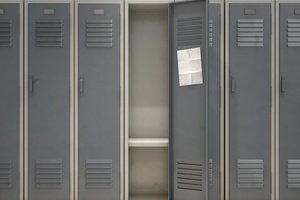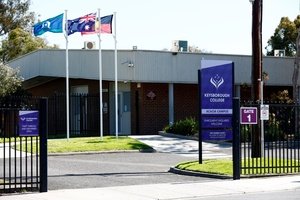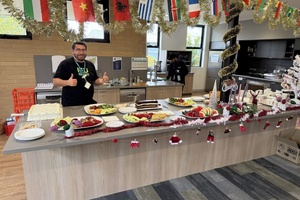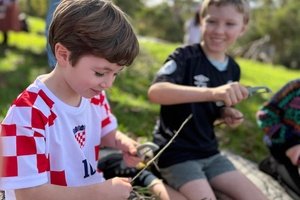“They asked us to do things, like help the home-ec assistant wash, or help the gardener do some work around the place,” Inder, now a senior researcher at AERO, says.
“At first we thought ‘these kids are really helpful and they care about school’, and that was definitely true, but it was also the reality that it was because they weren’t succeeding in the classroom – largely due to their lack of reading skills.
“They were actually using that as a tactic to avoid class, and therefore were falling further and further behind.”
It was a sad, if not devastating scene to bear witness to, Inder recalls, and one that has stuck with him to this day.
Despite his mantra ‘literacy and numeracy is everyone’s responsibility’, in his maths and science lessons Inder saw first-hand how weak reading skills impacted on students’ ability to access the content.
They were almost always denied the feeling of success.
“When they needed to apply new numeracy skills within context, if they didn’t have that background knowledge, then tackling the question and understanding the situation was really challenging.
“And as a result, they weren’t able to apply mathematical skills, and it was effectively and same in science.
“There seems to be quite a clear link between the students who could read the coursework, understand the vocabulary we were using, and how they could actually apply those ideas and demonstrate learning as well,” Inder says.
The national picture
Nearly 1 in 5 Australian students start secondary school at or below minimum standards for literacy.
Last year’s NAPLAN results found 1 in 10 students are not meeting new standards in literacy, and those with high levels of socioeconomic disadvantage are even more likely to be slipping behind.
Meanwhile, PISA 2022 found just 57 per cent of Australian 15-year-olds achieved the National Proficient Standard in reading.
In 2022, AERO conducted a survey asking secondary teachers and school leaders what they did to support struggling students to build their foundational literacy and numeracy skills.
“Most people in schools were trying something to support those students, people weren’t turning a blind eye, they knew it was an issue,” Inder explains.
“But when we asked them how confident they feel that what they're doing is best practice, in the context of literacy, 41 per cent said they were ‘not really’ or ‘not at all confident’.”
Resources for schools
This April, AERO plans to release a large suite of resources designed to serve as a ‘roadmap’ for secondary schools in how they can lift students with poor reading skills.
Specific assessments used to identify skill gaps, harnessing data to inform interventions, types of interventions and a ‘how to’ on progress monitoring will be mapped out in detail, Inder flags.
“It really steps people through within the context of reading, at quite a granular level, how they can actually deploy this in their school.
“So for people who are thinking of starting something or looking to tweak something they’ve already got in place, this will be really valuable.”
Early intervention is the most powerful tool secondary schools have in their arsenal to catch poor readers before they slide further behind, the expert says.
“[It’s about] having the robust data systems, being able to screen students to see who does need support.
“And I’d say in secondary school, you pretty much have to do that from day one, because you get students coming in from a range of backgrounds, from a range of primary schools with a range of ability levels, and so using those screening tools and types of assessments, they can tell you which students need support.
“And then more granular, detailed assessment can target those skills those students need support with,” Inder says.
While some students might lack decoding skills, others might struggle with comprehension – others might require intervention right across the board.
Follow the MTSS model
Schools should follow a multi-tiered system of supports (MTSS) model, with tier 1 applied to all students, tier 2 to some, and tier 3 to those who are in need of the most intensive support, Inder says.
“High quality tier 1 instruction given to all students is absolutely critical, because basically, if you can get your classroom instruction right, and the neuropsychology behind that, it ensures (fewer) students aren’t needing extra support…” Inder says.
‘High quality’ practices include explicit instruction, spacing and retrieval, and formative assessment.
It pays to keep coming back to students’ progress data too, he says.
“Because if you’re delivering intervention and you’re not seeing the dial move on the specific skills that you’re trying to improve, you might need to reflect on your own practice and make sure it’s being implemented correctly.
“You might need to try something different, try a new approach or look at the other conditions around the student to see why success isn’t being had, and keep working towards that.”
For secondary students, good reading skills are ultimately the ‘gateway to access the curriculum’, Inder warns.
“If they don’t have those foundational skills in reading, then it makes it really challenging for them to learn more concepts.”






